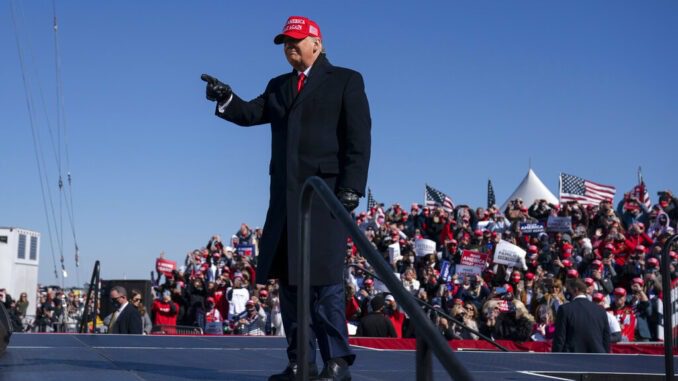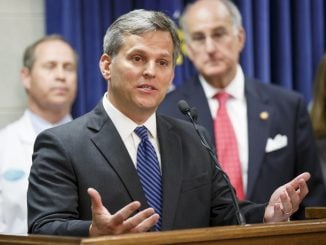
RALEIGH — North Carolina Democrats were hoping this November they would break the backs of Republicans, who after dominating state politics for much of the past decade saw their power erode in the 2016 and 2018 elections.
Instead, state Democrats had little to tout after Election Day beyond Gov. Roy Cooper’s close re-election, a narrow victory for Attorney General Josh Stein, and picking up two U.S. House seats largely handed to them by redistricting in 2019.
President Donald Trump again won North Carolina’s 15 electoral votes. U.S. Sen. Thom Tillis earned a second term over Democratic challenger Cal Cunningham, whose acknowledgement in the campaign’s final weeks of at least one extramarital affair derailed a potential upset. Republicans retained eight congressional seats and six Council of State positions. They will sweep all eight state appeals court races should Paul Newby stay ahead of Chief Justice Cheri Beasley following a recount and legal protests.
And the Democrats’ multimillion-dollar effort to take control of the state legislature before the next round of redistricting begins in 2021 failed, with the GOP actually picking up more General Assembly seats overall.
“It was a great day to be a Republican here in North Carolina,” state GOP Chairman Michael Whatley said.
Democrats are largely blaming the flame-out on tremendous turnout by Republicans committed to Trump, who beat Joe Biden by just 1.3 percentage points.
While statewide turnout exceeded 75%, a record for recent North Carolina history, Republicans up and down the ballot won handily in all but one of the 13 counties whose turnout surpassed 80%, according to State Board of Elections data. That helped the GOP counter Democratic advantages that ran up in urban counties and by mail-in balloting.
“Ultimately, it is Trump’s ability to motivate rural North Carolina to turn out and vote in record numbers,” said Morgan Jackson, a consultant for Cooper and Cunningham’s campaigns. Jackson said Cunningham’s “personal issues” in the final month contributed to changing the trajectory of that race. And he said Democrats were not able to run robust traditional get-out-the-vote operations because party members were less willing to knock on doors for fear of the COVID-19 pandemic.
GOP activists, meanwhile, knocked on 3 million doors, according to Whatley. Whatley said Trump’s mass rallies to North Carolina in the campaign’s final weeks, along with visits by Vice President Mike Pence and Trump family members, also contributed to GOP enthusiasm with early in-person voting and on Election Day. Biden, meanwhile, did not visit North Carolina in the campaign’s final 16 days.
Some Republicans, particularly legislative leaders, attributed electoral success to their legislative agenda of the past decade, including lower taxes, expanded opportunities for school choice for K-12 students and increased education funding.
“Those are policies that are broadly popular, even among groups that traditionally don’t support Republicans,” Senate leader Phil Berger said. Democrats in key legislative races attempted to make the GOP’s opposition to expanding Medicaid the pivotal issue in their campaigns, repeating a successful strategy from 2018.
Democrats see a silver lining with increased margins for their candidates compared to 2016 in urban counties already dominated by their party, as well as narrowed GOP vote advantages in suburban counties like Gaston, Union and Johnston. Population shifts likely will mean more legislative and congressional seats get created in areas that favor Democrats in 2021 redistricting.
“The (2020’s) are gonna be a decade of trench warfare,” veteran Democratic consultant Gary Pearce said. “Neither party is really able to get total control of government.”
Democratic strategists also hope GOP turnout diminishes when Trump is not on the ballot.
“Trump supporters are rabid for him,” said Thomas Mills, a Democratic consultant who worked with congressional candidate Patricia Timmons-Goodson. “I don’t think they’re Republicans. I think they’re gonna find out that in four years, in two years, those people are not gonna show up.”
It will in part be up to local Republican leaders to keep first-time and sporadic voters involved in future elections. In GOP-dominated Alexander County, 65 miles north of Charlotte, party Chairman Jack Simms said 137 people came to the party headquarters to register to vote for the first time ever or switch their party affiliation, often from Democratic. In previous elections, the county GOP might get 25 such registrations.
“I don’t think we’ll ever see a more energetic election like we’ve just witnessed,” Simms said. Can it be repeated? He replied: “It depends on who runs in the future.”



